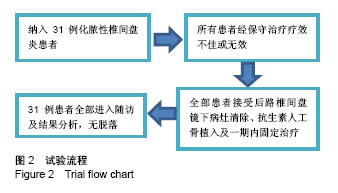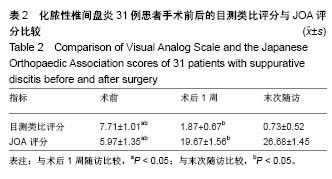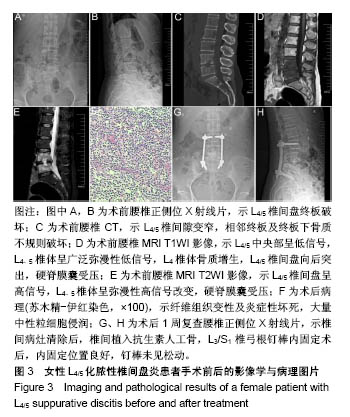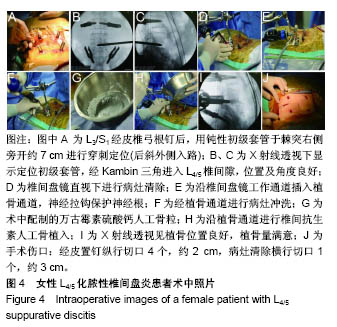| [1] Pola E,Taccari F,Autore G,et al.Multidisciplinary management of pyogenic spondylodiscitis: Epidemiological and clinical features, prognostic factors and long-term outcomes in 207 patients. Eur Spine J.2018;27(Suppl 2):229-236.[2] Petkova AS,Zhelyazkov CB,Kitov BD.Spontaneous Spondylodiscitis - Epidemiology, Clinical Features, Diagnosis and Treatment.Folia Med(Plovdiv).2017;59(3):254-260.[3] Vcelak J,Chomiak J,Toth L.Surgical treatment of lumbar spondylodiscitis: A comparison of two methods.Int Orthop. 2014; 38(7):1425-1434.[4] Herren C,Jung N,Pishnamaz M,et al.Spondylodiscitis: Diagnosis and treatment options. Dtsch Arztebl Int. 2017;114(51-52):875-882.[5] Zarghooni K,Röllinghoff M,Sobottke R,et al.Treatment of spondylodiscitis.Int Orthop.2012;36(2):405-411.[6] Choi EJ,Kim SY,Kim HG,et al.Percutaneous endoscopic debridement and drainage with four different approach methods for the treatment of spinal infection.Pain Physician. 2017;20(6): E933-E940.[7] Ito M,Abumi K,Kotani Y,et al.Clinical outcome of posterolateral endoscopic surgery for pyogenic spondylodiscitis: Results of 15 patients with serious comorbid conditions.Spine (Phila Pa 1976). 2007;32(2):200-206.[8] Fu TS,Chen LH,Chen WJ.Minimally invasive percutaneous endoscopic discectomy and drainage for infectious spondylodiscitis. Biomed J.2013;36(4):168-174.[9] 王春增,张兆川,赵猛,等.椎间孔镜下病灶清除冲洗治疗腰椎非特异性感染的疗效[J].实用骨科杂志, 2018,24(1):60-63.[10] Abbasi H,Abbasi A.Oblique lateral lumbar interbody fusion (OLLIF): Technical notes and early results of a single surgeon comparative study.Cureus.2015;7(10):e351.[11] 丁艳丽,杨静.骨科配戴腰围病人的规范健康教育指导[J].中国保健营养(上旬刊),2013,23(7):3994.[12] 李倩.腰围佩戴时间的长短对腰椎间盘突出症患者的影响[J].饮食保健, 2016,3(17):188.[13] Lener S,Hartmann S,Barbagallo GMV,et al.Management of spinal infection: A review of the literature.Acta Neurochir (Wien). 2018; 160(3):487-496.[14] Rutges JP,Kempen DH,van Dijk M,et al.Outcome of conservative and surgical treatment of pyogenic spondylodiscitis: A systematic literature review.Eur Spine J. 2016;25(4):983-999.[15] Tsai TT,Yang SC,Niu CC,et al.Early surgery with antibiotics treatment had better clinical outcomes than antibiotics treatment alone in patients with pyogenic spondylodiscitis: A retrospective cohort study.BMC Musculoskelet Disord. 2017;18(1):175.[16] 舍炜,陈根元,侯卫华,等.显微内窥镜下腰椎间盘摘除和传统开放手术治疗腰椎间盘突出症的Meta分析[J].中国组织工程研究与临床康复, 2010,14(48):9090-9094.[17] Foley KT,Smith MM,Rampersaud YR.Microendoscopic approach to far-lateral lumbar disc herniation.Neurosurg Focus.1999;7(5):e5.[18] Perez-Cruet MJ,Foley KT,Isaacs RE,et al. Microendoscopic lumbar discectomy: technical note. Neurosurgery.2002;51(5 Suppl): S129-S136.[19] Pao J,Chen W,Chen P.Clinical outcomes of microendoscopic decompressive laminotomy for degenerative lumbar spinal stenosis. Eur Spine J.2009;18(5):672-678.[20] 马向阳,杨浩志,邹小宝,等.一期极外侧入路病灶清除植骨融合闭式冲洗引流联合后路内固定术治疗原发性腰椎间隙感染[J].中国脊柱脊髓杂志,2018,28(8):726-731.[21] 刘海平,郝定均,王晓东,等.原发性腰椎间隙感染病灶清除植骨融合内固定临床疗效分析[J].实用骨科杂志,2017,23(5):390-394.[22] 杨小春,常龙,尚雁冰,等.后路病灶清除、植骨融合治疗非特异性腰椎椎间隙感染[J].中华骨科杂志, 2017,37(18):1136-1142.[23] 张成程,陈建明,李占清,等.后路病灶清除内固定+负载抗生素硫酸钙治疗腰椎间隙感染[J].西南国防医药, 2017,27(11):1220-1222.[24] Anagnostakos K, Koch K.Pharmacokinetic properties and systemic safety of Vancomycin-Impregnated cancellous bone grafts in the treatment of spondylodiscitis. Biomed Res Int.2013;2013:358217.[25] Sanicola SM,Albert SF.The in vitro elution characteristics of vancomycin and tobramycin from calcium sulfate beads. J Foot Ankle Surg.2005;44(2):121-124.[26] Laycock P,Cooper J,Howlin R,et al.In vitro efficacy of antibiotics released from calcium sulfate bone void filler beads.Materials. 2018;11(11):2265.[27] 魏劲松,曾荣,林颢,等.硫酸钙骨粉混合抗生素在腰椎原发性椎间隙感染手术治疗中的应用[J].颈腰痛杂志,2009,30(3):214-216.[28] Chen L,Cheng J,Li B,et al.Posterior debridement, interbody fusion, internal fixation for treatment of lumbar discitis.Zhongguo Gu Shang. 2017;30(5):475-478.[29] 李龙,盛伟斌,杨森,等.原发性腰椎椎间隙感染:病灶清除植骨及椎弓根螺钉置入内固定的联合修复[J].中国组织工程研究, 2015,19(13): 2063-2068.[30] Lim JK,Kim SM,Jo DJ,et al.Anterior interbody grafting and instrumentation for advanced spondylodiscitis.J Korean Neurosurg Soc.2008;43(1):5-10.[31] Wang X,Tao H,Zhu Y,et al.Management of postoperative spondylodiscitis with and without internal fixation.Turk Neurosurg. 2015;25(4):513-518. |
.jpg)







.jpg)